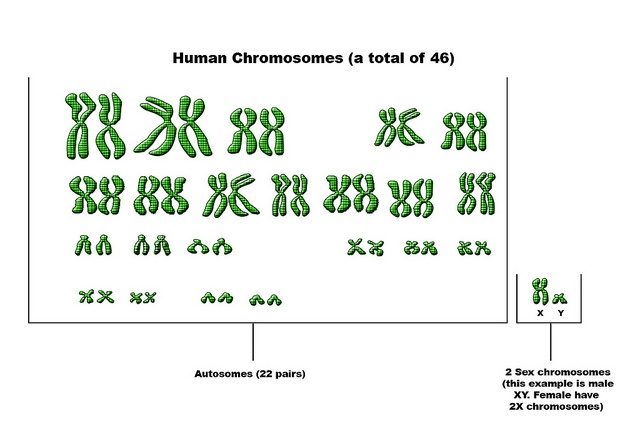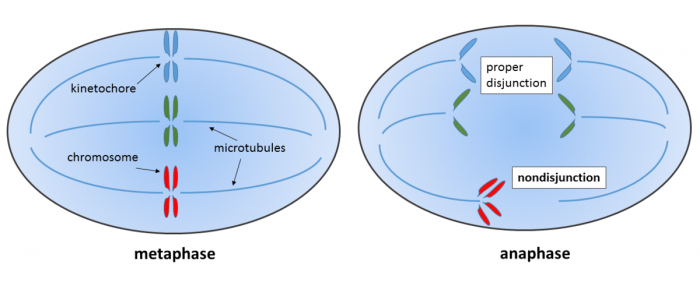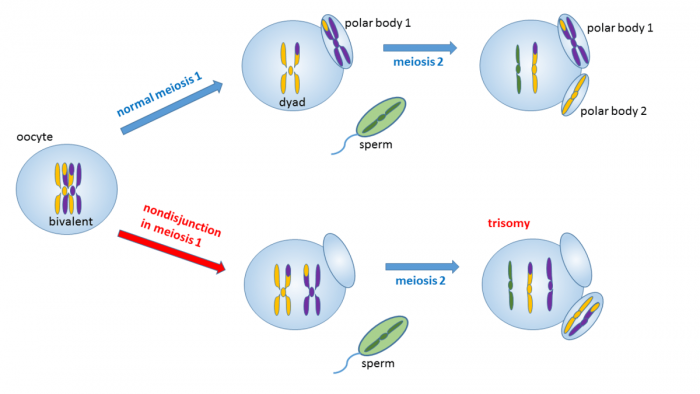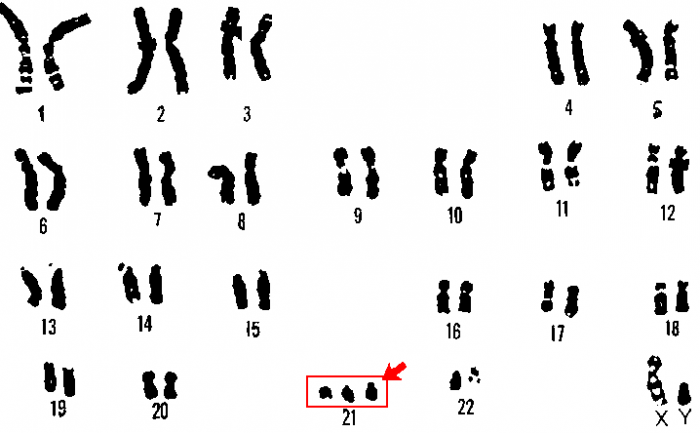
In every cell of your body exists strands of DNA, wound into tightly coiled structures called chromosomes. Chromosomes are packets of genetic information that contain the biological information for each living organisms. Chromosomes play an important role in hereditary as they contain the genetic information passed down from mother and father to offspring. Cells in the body reproduce by first creating a copy of their chromosome, then physically splitting into two distinct cells, each with a set of chromosomes. These mechanisms do not always work properly though, and errors can occur during cell division. In the context of genetics and molecular biology, nondisjunction refers to a failure of chromosomes to divide properly during cell division.
Nondisjunction results in an aneuploid—a cell that has an abnormal amount of chromosomes. The appropriate number of chromosomes for a cell differs depending on the species. Somatic cells in the human body, for instance, have 46 (2n). These 46 chromosomes come in 23 pairs, 22 autosomal pairs (XX) and 1 sex pair (XX or XY). Aneuploid somatic cells could have (2n−1) = 45, or (2n+1) = 47 chromosomes. Likewise, human gamete cells (sex cells) have one set of 23 (n) chromosomes. An aneuploid gamete cell could have (n−1) = 22 or (n+1) = 24 chromosomes.

Human diploid cells have 23 pairs of chromosomes for a grand total of 46. Credit: Zappys Technology Solutions via Flickr CC BY-2.0
There are a few types of aneuploidy that have their own special names:
-Monosomy is an organism having 1 chromosome where 2 should be present (2n−1)
-Trisomy is an organism having 3 chromosomes where 2 should be present (2n+1)
Aneuploidy applies in cases where cells have more (2n+2) or less (2n−3) chromosomes, though these situations are less common. A cell that has an extra complete set of chromosomes (3n) is not an aneuploid but is called a polyploid.
Changing the number of chromosomes in a cell affects the functioning of the cell and can have deleterious effects. Most chromosomal disorders in humans are caused by nondisjunction during cellular division.
Nondisjunction And Aneuploidy
Aneuploidy is caused by nondisjunction, a failure for homologous chromosomes or sister chromatids to separate properly during cell division. In humans and most other mammals, there are 3 places where nondisjunction can occur; during mitosis, meiosis I, and meiosis II. Nondisjunction during mitosis creates somatic cell aneuploids and nondisjunction during meiosis I & II results in gamete cell aneuploids.
Mitosis
Somatic cell division is preceded by the replication of chromosomes during cellular interphase. Each chromosome forms an identical copy called a “sister chromatid” that is connected to the original chromosome at the centromere. During mitotic anaphase, the microtubule spindle apparatus attaches to the sister chromosomes and migrate to the poles of the cell, pulling the sister chromatids apart. Afterward, the cell membrane splits and reforms into two distinct cells, each with an identical copy of DNA.

Nondisjunction is caused by a failure for sister chromatids to separate properly. Credit: Wpeissner via WikiCommons CC BY-SA 3.0
Nondisjunction in mitosis occurs during anaphase when sister chromatids fail to be properly separated. One cell gets both copies of the sister chromatids, and the other gets none. The result is that one daughter cell has an extra chromosome, and the other daughter cell is missing one. Changes due to mitotic disjunction cannot be passed down to offspring because somatic cells are not sex cells, but they can cause certain types of cancer.
Meiosis I & II
Meiosis is the process by which human sex cells reproduce to produce gametes cells with half the normal number of chromosomes (23) The gametes in humans are called sperm and eggs. Meiosis I begins in much the same way that mitosis does, the diploid cell begins by copying its chromosomes. Chromosomes begin to pair up, creating what are called homologous pairs. Theses homologous pairs crossover at physical points, exchanging genetic information to create unique combinations of genetic material. During the first mitotic division, the homologous pairs are separated and create 2 cells with a full set of chromosomes. During meiosis II, these two daughter cells split again, this time without first copying their sets of chromosomes. All in all, the entire process of meiosis creates 4 daughter haploids cells, each with 1 set of chromosomes that are related to but genetically distinct from the parent cells.
Nondisjunction can happen at 2 places during meiosis. Nondisjunction can occur during meiosis I when homologous pairs of chromosomes fail to split evenly leading to one cell with (2n−1) chromosomes and the other with (2n+1) chromosomes. Further meiotic division of these cells can result in aneuploid gametes.

Trisomy resulting from nondisjunction during meiosis I. Credit: Wpeissner via WikiCommons CC BY-SA 3.0
Nondisjunction can also occur in meiosis II if sister chromatids fail to separate properly. This process is similar to nondisjunction in mitosis, but it results in the formation of aneuploid gametes instead of somatic cells. If an aneuploid gamete combines with a normal gamete during sexual reproduction, the resulting zygote, and later embryo, will also be aneuploid. For example, if an egg cell with one extra chromosome (n+1) combines with a sperm cell with a normal amount (n), the resulting zygote will be an aneuploid and have (2n+1) chromosomes.
Aneuploidy And Genetic Disorders
Virtually all chromosomal disorders are due to errors in chromosome separation during cell division. Aneuploidy can lead to health problems because the presence of extra or absence of genetic information can throw the body’s mechanisms out of balance. Without certain sections of DNA, the body will not know to create certain proteins, which can have adverse effects. Too much genetic information and cells can overproduce proteins, which can also cause problems.
All human zygotes that are missing an autosomal (non-sex) chromosome will fail to develop in utero because the genetic information for constructing necessary proteins simply does not exist. Thus, all human autosomal monosomies are fatal. The only known human monosomy that is non-fatal is called Turner syndrome and is characterized by a partial or missing sex chromosome. Individuals with Turner syndrome only have a total of 45 chromosomes, 22 pairs, and a single chromosome sometimes represented as XO. Individuals with Turner syndrome develop as women but are normally smaller in stature and unable to have children without reproductive technologies. Women with Turner syndrome have normal intelligence, but a shorter life expectancy due to a higher likelihood of heart problems and diabetes. The occurrence of Turner syndrome is considered to be random and does not seem to be significantly linked to any environmental factors.
The most common trisomy that is non-fatal is Down syndrome, otherwise called trisomy 21. Individuals with Down syndrome have 3 copies of chromosome 21, instead of 2. This trisomy is most often caused by nondisjunction during meiosis in female egg cells. Down syndrome occurs in 1 in 1,000 babies per year, with the likelihood increasing with the mother’s age. Down syndrome is associated with a characteristic physical appearance, mild to moderate intellectual disability, and delays in physical growth. The average IQ of adults with Down syndrome is 50, though this number varies widely. Individuals with Down syndrome are at a higher risk for heart disease, thyroid disease, and some cancers, but regular medical care can drastically reduce these odds. The average lifespan for a person with Down syndrome in the industrialized world is 60-65.

A karyotype of an individual with Down syndrome. Notice the presence of an extra copy of chromosome 21. Credit: WikiCommons CC0 1.0
Other trisomy disorders include Edwards syndrome (trisomy 18) and Patau syndrome (trisomy 13). Both Edwards and Patau syndrome are associated with intellectual and developmental disabilities, heart problems, microcephaly, and a weakened immune system. Most cases of both syndromes are fatal pre-birth, or individuals only live a few months or years.
Klinefelter syndrome is sex chromosome aneuploidy characterized by the presence of an extra X sex chromosome in males. Males with Klinefelter syndrome have sex chromosomes XXY instead of the normal XY. Klinefelter syndrome can arise due to a nondisjunction event during meiosis in either parent. Individuals with Klinefelter syndrome tend to be physically normal, aside from being sterile. In some cases, symptoms include greater height, less muscle mass, poor coordination, and breast growth. Males with Klinefelter syndrome are normal intelligence but have a higher likelihood of speech problems and reading difficulties. Symptoms can be more severe in cases of more than 1 extra chromosome (XXXY and XXXXY). Klinefelter syndrome occurs in roughly 1-to-2 out of every 1,000 male births.
In general, sex chromosome aneuploidies are more manageable than autosomal aneuploidies. This is because human sex-chromosomes are capable of deactivating X chromosomes so that their genes are not expressed. Females with XX do this normally, one X chromosome is not expressed. One X chromosome gets crumpled up into a structure called a Barr body. Most genes on the Barr body are inactive and so are not transcribed.
In cases with sex-chromosome aneuploidies, the same mechanisms do a relatively good job of deactivating the extra X chromosomes, which can lessen harmful effects. For example, triple X syndrome is an aneuploidy where a woman has 3 X chromosomes (XXX). Women with triple X syndrome are physically normal and are capable of having children. The cell will also deactivate the extra X chromosome so that the cell has 2 Barr bodies in it. The body is capable of at least partially neutralizing the effect of the extra X chromosome, so the effects are not as deleterious.








